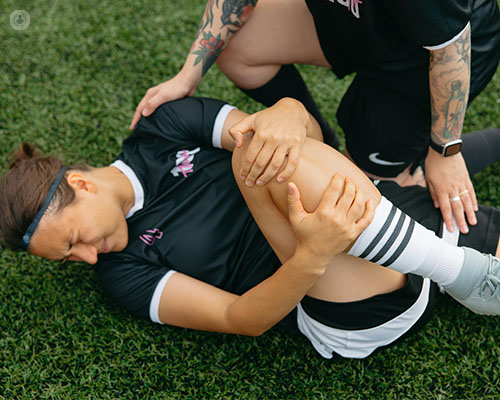Torn meniscus cartilage repair: all you kneed to know
Written in association with:The knees each have a piece of cartilage that acts as padding and shock absorption between the femur (thigh bone) and the tibia (the shin bone). When we run, jump, and dance, the meniscus protects us from the impact of hitting the ground. The meniscus can be damaged due to arthritis, traumatised due to an injury like twisting your knee, or may tear even during a ubiquitous movement like standing up. An injury like this can take you off your feet for a long time, so we asked Mr Andrew Edwards, an orthopaedic and traumatology surgeon, to tell us how a torn meniscus cartilage can be repaired.

A meniscus cartilage tear will have the following symptoms:
- Swelling of the knee
- Pain or sensitivity of the knee
- Stiffness and difficulty manoeuvring the knee
- Weakness of the knee when trying to stand or walk
- Crunching or clicking sensation when manoeuvring the knee
How can a torn meniscus cartilage be treated?
A torn meniscus cartilage can heal on its own, eventually, but it will take a long time and functionality may be limited after. For minor tears, it is best to cease exercise and physical activities for a few days so that the knee can rest, ice the knee, avoid hot baths or massaging the knee, and keep the leg raised when sleeping. Painkillers can be used to manage any pain.
However, for more serious tears to the meniscus cartilage, surgery may be required to correct the damage.
What surgery can repair a torn meniscus cartilage?
Most meniscus surgeries are done with the minimally invasive knee arthroscopy. After an anaesthetic is applied to the area, small incisions are made around the knee to allow the orthopaedic surgeon access to a small camera (the arthroscope) and the tools needed to treat the tear. They usually take around an hour, and are an outpatient procedure.
To repair the meniscus tear, the surgeon will stitch the tear together with absorbable sutures. If the tear is severe, they may need to remove parts or all of the meniscus. In a partial meniscectomy, the damaged cartilage is trimmed away, and in a meniscus replacement, the meniscus is replaced with a replacement meniscus from a donor (called an allograft), and is a procedure best utilised for a critical tear and for those who are younger than 50 but have knee arthritis.
What happens after torn meniscus cartilage repair surgery?
After surgery, the patient will need to keep weight off the knee and not use it as it heals. They should be given a knee brace and crutches to assist them in this time. Physical rehabilitation is recommended to stabilise and strengthen the knee again. The healing process can take several months, and intense sports should be avoided for up to a year, but normal walking can resume after a few weeks.
If you believe you may have torn your meniscus cartilage, or are struggling with knee issues, book an appointment with Mr Edwards via his Top Doctors profile.


